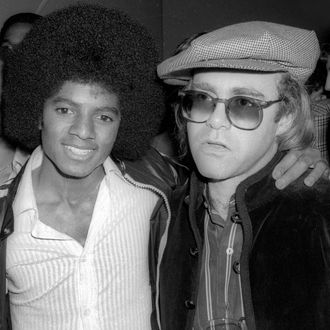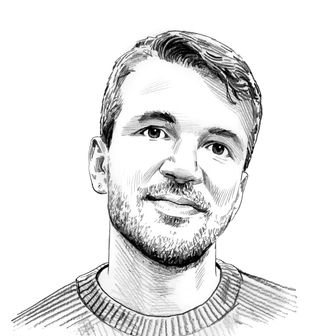
Seemingly every celebrity to have walked the earth in the ’70s and ’80s makes an appearance in Elton John’s new memoir, Me: the famed, the disgraced, and everyone in between. And Michael Jackson, whose legacy has been reevaluated after new child-molestation allegations came out in the documentary Leaving Neverland, is not exempt from John’s pen. In the book, John describes the mid-1990s lunch at which his mom met his future husband David Furnish for the first time — and Michael Jackson was also a guest. A psychiatrist who John had also invited asked if he could take “his client Michael Jackson,” who was in England at the time. “I could hardly refuse,” John writes.
John first met Jackson in his teens: “After a gig I played in Philadelphia, Elizabeth Taylor had turned up on the Starship [John’s private jet] with him in tow,” he remembers. “He was just the most adorable kid you could imagine.” Yet over time, that changed. “God knows what was going on in his head, and God knows what prescription drugs he was being pumped full of, but every time I saw him in his later years I came away thinking the poor guy had totally lost his marbles,” John continues. “He was genuinely mentally ill, a disturbing person to be around. It was incredibly sad, but he was someone you couldn’t help: he was just gone, off in a world of his own, surrounded by people who only told him what he wanted to hear.”
When John called Furnish to say that Jackson would be coming to the lunch, he “was interrupted by an anguished yell of ‘are you fucking KIDDING me?’” “No, I insisted, it wouldn’t be as strange as he might expect,” John writes. “In that respect at least, I was absolutely right. The meal wasn’t as strange as I might have expected. It was stranger than I could have imagined.” As John tells it:
It was a sunny day and we had to sit indoors with the curtains drawn because of Michael’s vitiligo. The poor guy looked awful, really frail and ill. He was wearing make-up that looked like it had been applied by a maniac: it was all over the place. His nose was covered with a sticking plaster which kept what was left of it attached to his face. He sat there, not really saying anything, just giving off waves of discomfort the way some people give off an air of confidence. I somehow got the impression he hadn’t eaten a meal around other people for a very long time. Certainly, he wouldn’t eat anything we served up. He brought his own chef with him, but didn’t eat anything he made, either. After a while, he finally got up from the table without a word and disappeared. We finally found him, two hours later, in a cottage in the grounds of Woodside [John’s house] where my housekeeper lived: she was sitting there, watching Michael Jackson quietly playing video games with her eleven-year-old son. For whatever reason, he couldn’t seem to cope with adult company at all.
Later, John reflects on Jackson’s behavior and career, writing, “I honestly think that’s one of the things that tipped Michael Jackson over the edge: he was convinced he could make an album bigger than Thriller, and was crushed every time it didn’t happen.” Police first investigated child-molestation claims against Jackson in 1993, and a family filed a lawsuit around the same time; Jackson also allegedly entered rehab in 1993 for an addiction to painkillers, but died with high levels of the sleep medicine propofol in his body. John, who was playing a show upon the news of Jackson’s death, dedicated “Don’t Let the Sun Go Down on Me” to the late performer. He hasn’t directly addressed the allegations against Jackson.


